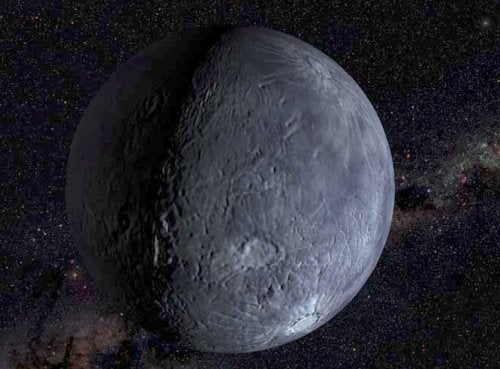The second-largest object orbiting in the Kuiper Belt, Quaoar, was resurfaced in the last 10 million years, say planetary scientists David Jewitt and Jane Luu. They suggest either impacts dredged up comparatively fresh ice from Quaoar’s interior — or low-temperature volcanic outgassing gave it a new coating.
Using the Subaru 8-meter telescope on Mauna Kea, Jewitt (Institute for Astronomy, University of Hawaii) and Luu (Lincoln Laboratory, MIT) took visual and infrared spectra of Quaoar, which orbits at an average distance of 43.3 astronomical units (AU) from the Sun. (Earth orbits at 1 AU.) Quaoar has a diameter of 780 miles (1,260 kilometers), making it more than half the size of Pluto and slightly larger than Pluto’s moon, Charon. Jewitt and Luu discovered the first Kuiper Belt object in 1992, and roughly 1,000 more are known now.
“We found two substances in Quaoar’s spectrum,” says Jewitt, “the crystalline form of water ice and what we identify as ammonia hydrate.” Both offer clues to Quaoar’s recent history because neither could remain long at its surface, due to bombardment by energetic charged particles from the Sun and cosmic rays from the galaxy.
“The ammonia and crystalline ice would be destroyed in about 10 million years,” Jewitt says. “This implies Quaoar gets recoated on that time scale or faster.”
Ice that forms below -260° Fahrenheit (110 kelvins) is termed amorphous because the water molecules stick together in a random pattern. But if ice forms at 110 kelvins, or is heated above that temperature, it becomes crystalline, with its molecules assembling into a regular lattice. Jewitt explains that crystalline ice reverts to amorphous as cosmic rays smash its regular pattern. Ammonia hydrate also breaks down.
But the big question, he says, is how Quaoar got resurfaced. “Finding crystalline ice tells us the surface was heated above 110 kelvins. Although that’s cold, it’s definitely warmer than Quaoar’s surface temperature, which is 50 kelvins, or -370° F.
Quaoar’s surface would present a strange picture to a visitor from Earth, Jewitt says. “It’s coated in what many of us think is a complex hydrocarbon material. It is so, so cold out there that everything is frozen solid. At room temperature, the organic goop might feel sticky, but in the Kuiper Belt, it’s rock-hard.”
The researchers see two scenarios for giving Quaoar a face-lift. In the first, heat from decaying radioactive elements within Quaoar warms the ice, while meteorite impacts dredge up the ammonia and ice and strew them over the surface. “Another possibility,” Jewitt says, “is that buried ice gets blown out onto the surface by gas released by internal heating deeper down, in a kind of cryovolcanic burp.”
In a commentary in the same issue of Nature where Jewitt and Luu published their results (December 8, 2004), David Stevenson of Caltech observes that an object of Quaoar’s size should have a warm interior. Deep inside, he says, water and ammonia (working as anti-freeze) might combine to make a “lava” that could reach the surface via cracks and erupt — or be excavated by meteorite impacts.
Says Stevenson, “We shouldn’t exclude the possibility of volcanism in icy, volatile-rich worlds at the outer reaches of the solar system.”










